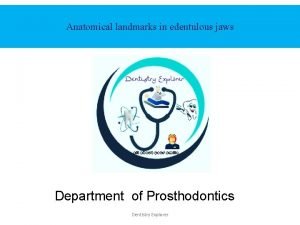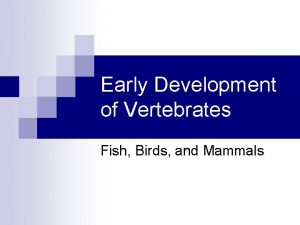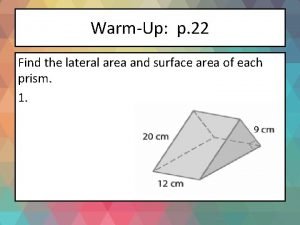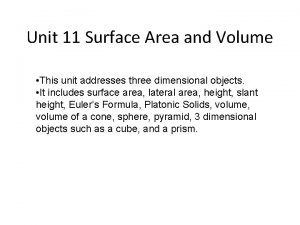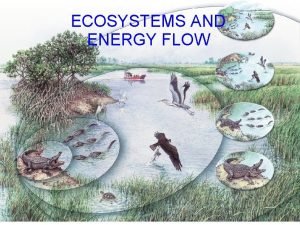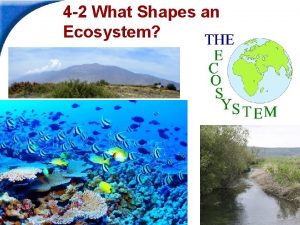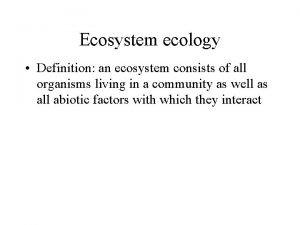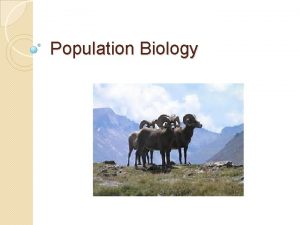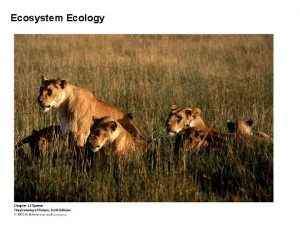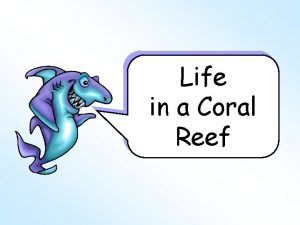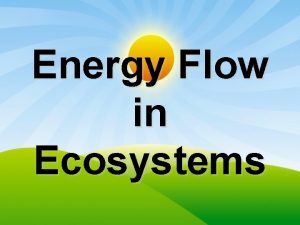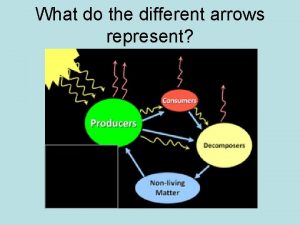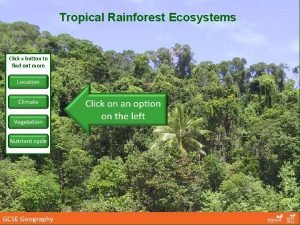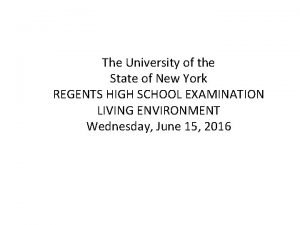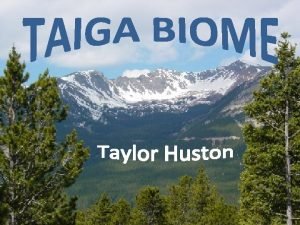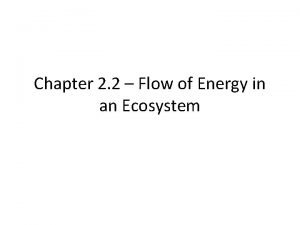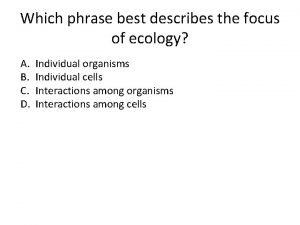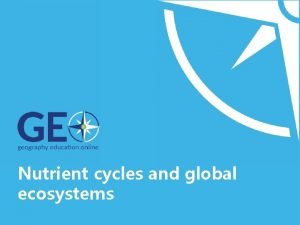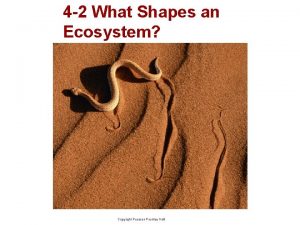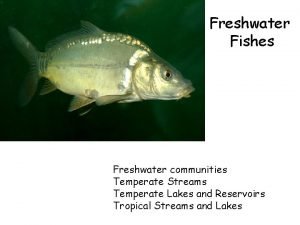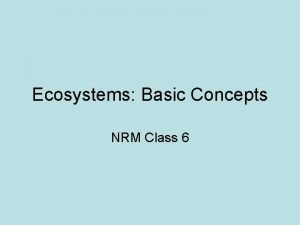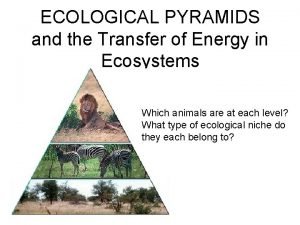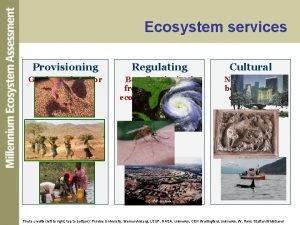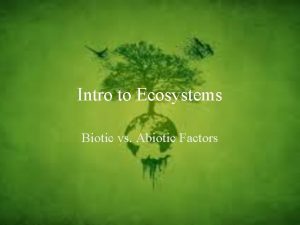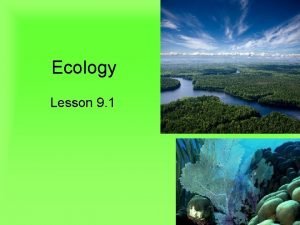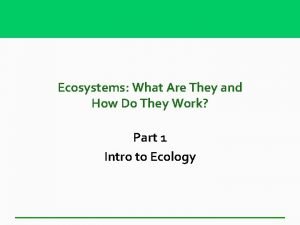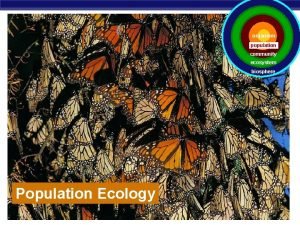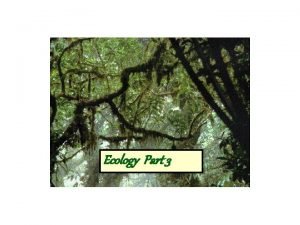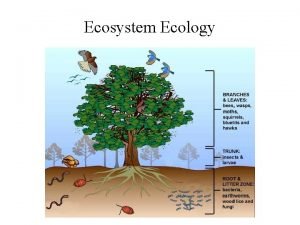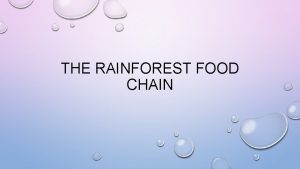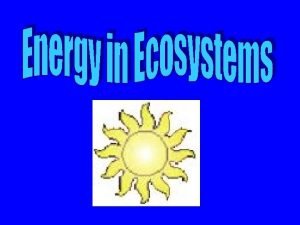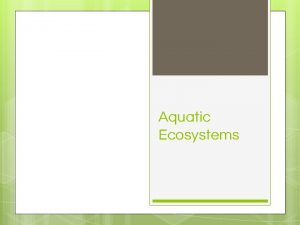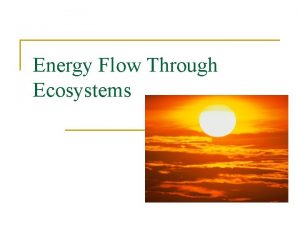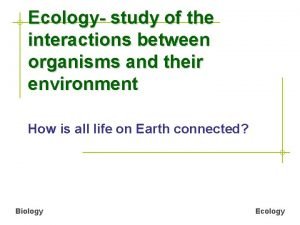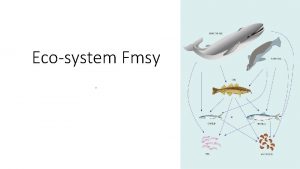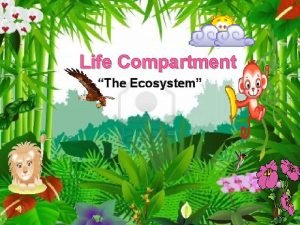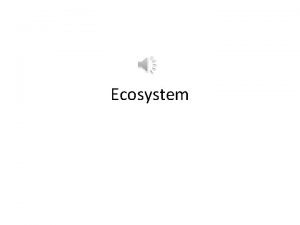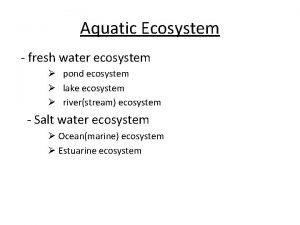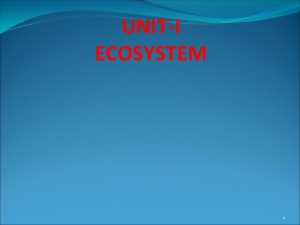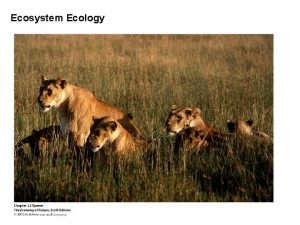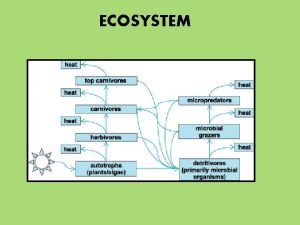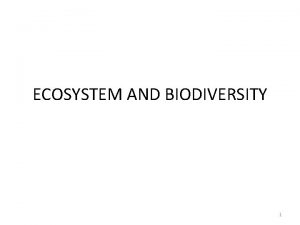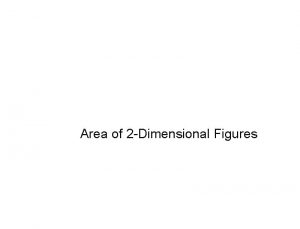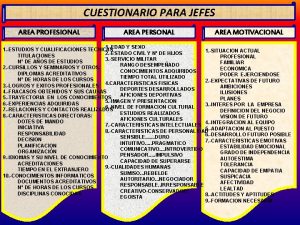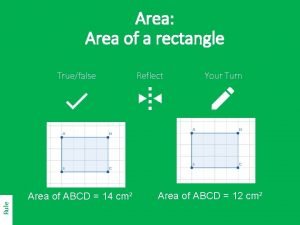Ecosystem ECOSYSTEM An ecosystem is an area in
























































- Slides: 56

Ecosystem

ECOSYSTEM � An ecosystem is an area in which there exists relationships between living organisms themselves and the living organisms and the non-living environment. � Some examples of ecosystems are: a river, a grassland, a fallen rock. � The study of all the relationships in an ecosystem is called ecology.

BIOTIC AND ABIOTIC FACTORS: � From it is clear that the ecosystem is made up of 2 components. � The living components are also called biotic components or factors. � The non-living components are also called abiotic components or factors.

BIOTIC COMPONENTS � The biotic components are the plants and animals. � It also includes organisms such as the fungi and lichens as well as the very small organisms like bacteria. � The bacteria are so small that it can be seen only with a microscope. � Such organisms that are invisible to the naked eye are called micro-organisms. � Some algae and fungi are also examples of micro-organisms.

BIOTIC COMPONENTS PRODUCERS, CONSUMERS AND DECOMPOSERS. � Producers: These are biotic factors that have the ability to make their own food (autotrophic). They are able to do this by absorbing energy from the sun using green chlorophyll. The process by which they are able to manufacture their own food by using the radiant energy is called photosynthesis.

BIOTIC COMPONENTS CONSUMERS � Consumers: These are organisms that are unable to manufacture their own food. (heterotrophic) Are you able to tell why? There are 3 categories of consumers. These 3 categories are:

HERBIVORES: Herbivores: these are organism that obtain their food from plant matter. Can you list some examples?

CARNIVORES: � Carnivores: these are the organism that feed on animal matter only. Name some examples.

OMNIVORES � Omnivores: these are organisms that feed on both plant and animal matter. � List some examples.

BIOTIC COMPONENTS DECOMPOSERS � These are organisms that feed on dead organic matter. � They are usually micro-organisms. � But some decomposers can be macroscopic e. g. earthworms. � Name some examples of decomposers. � As they break down the bodies of the dead organic matter they release important substances back into the environment. � These substances then can be used by producers. � Water, carbon dioxide, mineral salts and energy in the form of heat are some of the substances that are released by decomposers.

SOMETHING FOR YOU TO DO: Explain why decomposers are important to the environment.

SOLUTION: � They are important because they release important nutrients e. g. carbon dioxide, heat energy, water and mineral salts back into the soil so that it can be used by other green plants.

ABIOTIC COMPONENTS: � Abiotic factors can be placed into 3 groups. � These 3 groups are : Climatic factors. Edaphic factors Physiographic factors We shall look at all these factors.

CLIMATIC FACTORS � Temperature: Remember the places closer to the equator are warmer than those places near the poles. The temperature of an area can determine the plant life growing in that area. Animals are also affected by the temperature. Ectothermic animals rely on the external temperatures to determine their body temperatures. Their temperatures vary with the outside temperature. Endothermic animals generate heat internally and generally maintain a constant temperature.

Some animals like the ectohermic animals become inactive in the cold winter months because the temperatures are so low. Some of these animals hibernate to overcome the cold weather. Some animals like the snail also become dormant (aestivate) when the weather is very dry. *

CLIMATIC FACTORS TEMPERATURE Some plants experience excessive water loss as a result of the high temperature. The process responsible for this high water loss is called transpiration. However plants have many adaptations to reduce the water loss. The picture alongside shows some of these adaptations. Can you explain these adaptations ?

SOLUTION Adaptation of plants to reduce water loss � Leaves are long and thin to reduce the surface area to reduce water loss. � Leaves are covered with a thick cuticle to reduce water loss. � Leaves have more stomata on the lower surface to reduce water loss by transpiration and these stomata may be sunken. � Leaves may be covered by tiny white hairs to reflect the sunlight so that water loss can be reduced. � Some leaves maybe reduced to thorns to reduce the surface area exposed to the sun thereby reducing water loss. � Stems may be able to store water to survive the dry months.

SOMETHING FOR YOU TO DO: � Define 1. 2. 3. 4. 5. � 1. 2. � the following terms: Hibernation Aestivation Transpiration Exothermic Endothermic Differentiate between the following terms Hibernate and aestivate Ectothermic and endothermic Explain how animals are able to overcome adverse weather conditions.

SOLUTION: � Definitions: 1. 2. 3. 4. 5. An inactive state that enables animals survive the cold winter months. An inactive state that enables animals survive the hot, dry months. The loss of water in the form of water vapour from the aerial parts of the plant especially the stomata. Animals whose body temperature changes with the temperature of the environment. Animals whose body temperature remains constant.

SOLUTION: � Differences Hibernation is an inactive state to survive the cold winter months, while aestivation is and inactive state to survive the hot, dry months. Exothermic animals are animals whose body temperature changes with that of the surrounding while endothermic animals are those whose body temperature remains constant.

SOLUTION: � Adaptations to adverse conditions Some animals e. g. dog curl up in cold weather so that the long fur is exposed to the cold wind keeping them warm. Animals may aestivate to escape hot, dry conditions, while others may hibernate to survive cold winter conditions. Some animals go into the burrows to escape the heat e. g. Ground squirrels.

CLIMATIC FACTORS LIGHT � Light is needed by green plants for the process of photosynthesis. Plants will always be in competition with each other for light. Here are some examples: When plants are crowded together they will grow thin and tall in the hopes of receiving light. Some plants will climb on others in an attempt to reach the light. Example: vines Still others will grow on larger trees to reach the sunlight. Example: epiphytes


This is an example of an epiphyte. It grows on the larger tree only to get to the sunlight. It does not depend on the tree for any nutrients. All nutrients and water comes from the rainwater. It only uses the tree for support.

VINES Vines also only use the other plant for support. It is not dependent on the tree for food, it only uses the tree to reach the sunlight.

CLIMATIC FACTORS WATER � Water is used by both plants and animals for many different physiological processes. � Plants need water for photosynthesis. � While animals need water for digestion and transport of food and wastes. � Therefore plants will adapted to absorb and retain as much water as possible while animals try to retain as much water as possible.

� Hydrophytes are plants that live in water or around large amounts of water. � These plants are adapted to live in water in the following ways: They do not have root hairs because water is absorbed through the roots, stems and leaves. They do not have conducting tissue because each organ is able to absorb water. Supporting tissue is also absent because the plant is supported by the water. Since water loss by transpiration is not a problem these plants lack some the adaptations of terrestrial plants, for example the leaves of these plants do not have cuticles. Try this question: Explain the value of the hydrophytes not having a cuticle

HYDROPHYTES Here are two pictures of hydrophytes As you can see some of them have only their roots in water, while the others have only their leaves and flowers floating on the surface. Some Hydrophytes are also submerged in the water.

CLIMATIC FACTORS TERRESTRIAL PLANTS � Terrestrial plants are plants that live on land. � The biggest problem facing these plants is the lack of water. � These plants have to be able to absorb water and keep the water they absorb. � Plants can be grouped according to their water needs: a. Hydrophytes: plants that need an abundance of water b. Mesophytes: plants that need a moderate amount of water c. Xerophytes. : plants that can live with very little water.

CLIMATIC FACTORS: XEROPHYTES: � Xerophytes are adapted to live in extremely dry conditions in the following way: Some plants have leaves that are very close to each other. These leaves overlap each other and reduces the surface area exposed to the sunlight. This would reduce water loss. In some xerophytes like the one alongside these leaves have been reduced to thorns. Can you explain why this is an advantage for this plant?

� Some of these plants have very thick waxy cuticles. Can you explain the purpose of this cuticle. They also have more stomata on the lower surface than upper. Why? The stomata may also be sunken. Can you explain how this reduces water loss.

SOLUTION � The xerophytes have thick cuticles to reduce water loss by transpiration. � There are more stomata on the lower surface to reduce water loss by transpiration � Sunken stomata are present to reduce transpiration and therefore water loss.

CLIMATIC FACTORS ANIMAL ADAPTATIONS � Aquatic animals are those animals that live in water. � Terrestrial animals are those animals that live on land. � These animals have special features, structures and behavior that enables them to live in their particular habitat.

CLIMATIC FACTORS AQUATIC ANIMALS � These animals are adapted to live in water. � They have gills that enable them to extract oxygen from water. � They also have fins to enable them to swim and maintain their balance in water. Some aquatic animals are able to breathe by means of lungs, example dolphin, whales and seals.

CLIMATIC FACTORS TERRESTRIAL ANIMALS � Some animals are able to live in dry areas. � Here are some examples: sects have exoskeletons that elp to reduce water loss by vapouration Camels are able to live for long periods without water

CLIMATIC FACTORS: TERRESTRIAL ANIMALS The kangaroo rat is able to go long periods without water. It obtains its water from the food it eats. Reptiles are able to reduce water loss because they are covered by dry horny scales

ATMOSPHERIC GASES: � The atmosphere contains air, a mixture of gases. � Some of the more important gases that make up the air are: oxygen, carbon dioxide, nitrogen and water vapour. � The composition of these gases are about 78% nitrogen, 21% oxygen and 0. 03% carbon dioxide. � Oxygen is required by the both plants and animals for the process of cellular respiration. � During the process of photosynthesis plants absorb carbon dioxide, which is a requirement of photosynthesis.

ATMOSPHERIC GASES: � Nitrogen is required by plants to manufacture proteins. � However plants cannot absorb nitrogen as the N 2 gas as it occurs in the atmosphere. � Plants are only able to absorb nitrogen as a nitrate. � Therefore the nitrogen has to be first converted to nitrate before it can be absorbed. � Remember animals get their nitrogen from the plants they eat or other animals that may have eaten plants.

ATMOSPHERIC GASES: PLANT ADAPTATIONS FOR GASEOUS EXCHANGE. � Young and green plants have stomata on their leaves and stems for gas exchange. Stomata are tiny openings that allow gases to enter and leave. Woody plants have tiny pores called lenticels on their stems for gaseous exchange. � Hydrophytes absorb gases through their entire body surface because there is less dissolved gases in water than in air. They are able to do this because their surface is not covered by cuticle. Lenticels �

SOMETHING FOR YOU TO DO � Explain how lenticels and stomata are similar in their function but different in their structure,

SOLUTION: � Both the lenticels and stomata are used for the exchange of gases in plants. But the stomata are pores that are found in the stems and leaves of herbaceous plants, while lenticels are pores found on the stems of plants that have undergone secondary thickening.

ATMOSPHERIC GASES ANIMAL ADAPTATIONS FOR GASEOUS EXCHANGE Aquatic animals have many different adaptations for absorbing gases the most common being the gills of fish. These gills have a large surface area therefore as much oxygen can be absorbed. � Water beetles take air bubbles under water for gaseous exchange � This is a diagram of the spotted water beetle the blue bubble at the back is a part of the air bubble taken under water for gaseous exchange

EDAPHIC FACTORS SOIL TYPES � There are 3 types of soil: sand, loam and clay. � Plants generally grow best in loam soil because it has a good water holding capacity, and is well aerated. It also has a high humus content. � The loam soil has a good water holding capacity because it is made up of medium sized particles. � Plants don’t grow well in sandy soil because the soil is very loose and does not offer much anchorage. � The large particles of sandy soil provides it with a poor water holding capacity. � Clay is made up of very fine particles that become sticky when wet. � Therefore it has a high water holding capacity. � It is not good for plants because the roots can become waterlogged.

EDAPHIC FACTORS SOIL ACIDITY OR ALKALINITY: � The p. H scale can be used to measure the acidity or alkalinity of substances in solution. � An example of a p. H scale is shown below. � Different plants require soil with different p. H to survive. � Most plants prefer slightly acidic to neutral soil while other plants require alkaline soil.


PHYSIOGRAPHIC FACTORS � Physiographic factors are those factors that deal with the physical nature of the area. � Example of such factors are slope of land, altitude and for our studies position of area in relation to sun. � The physiographic factors that we will discuss are: a) Aspect b) Altitude.

PHYSIOGRAPHIC FACTORS ASPECT � Aspect refers to the direction a slope faces. � In the southern hemisphere the suns rays come from the north therefore the north facing areas receive more light than the south facing slopes. � The north facing areas would be warmer and drier than south facing slopes. � The north facing areas are drier because of increased evaporation. � Therefore shade loving plants like ferns would be found on the south facing slopes and xerophytes would be found on the drier, warmer slopes. � The south facing slopes would have more plant and animal life because more water is available.


PHYSIOGRAPHIC FACTORS ALTITUDE � Altitude refers to the height of the land above sea level. � The climate of areas found at higher altitudes is very different from places at lower altitude. � The areas at higher altitude have lower temperatures, atmospheric pressure and are exposed to stronger winds. � While those areas at lower altitudes have warmer temperatures, higher atmospheric pressures and lighter winds. � These differences means that the plant and animal life in these areas are very different from each other.

PHYSIOGRAPHIC FACTORS: EFFECTS OF ALTITUDE ON LIVING ORGANISMS. � Pine trees that grow on the slopes of mountains are cone shaped to allow the snow to fall off. They have very well developed roots to absorb whatever little water that may be available. � Green and black mambas are found in the warmer coastal areas while the Berg adder is found more commonly in the cooler mountainous areas. � Fish like the trout are found in rivers at high altitude because these waters are colder. � People living in the coastal areas have difficulty in breathing in the higher inland areas because of the lower pressure and therefore less oxygen at the higher altitudes.

� Winter –hibernation, Summer- aestivation. � Summer rainfall vs winter rainfall and growth � Deciduous vs evergreen plants � Winds during spring linked to wind pollination.

� Activity �Page 3. 2. 8 246

TERMINOLOGY: � Ecosystem: an area in which there are relationships between the living organisms themselves and their non-living environment. � Ecology: a study of all the relationships within an ecosystem. � Abiotic: non living factors of an ecosystem � Biotic: living factors of an ecosystem. � Micro-organism: organisms that are so small that they can only be seen under a microscope. � Producers: organisms that are able to manufacture their own food using the radiant energy of the sun. � Consumers: these are organisms that are unable to manufacture their on own food.

TERMINOLOGY � Photosynthesis: process during which green plants use the radiant energy of the sun to make their own food. � Decomposers: organisms that break down dead and decaying matter, releasing nutrients so that they, maybe re-used. � Herbivores: organisms that feed on plant matter only. � Carnivores: organisms that feed on animal matter only. � Omnivores: organisms that feed on both plant and animal matter.

TERMINOLOGY: � Ectothermic: these are organisms whose body temperature changes with the temperature of the surroundings. � Endothermic: these are organisms whose body temperature remains constant. � Transpiration: process during which plants loose water in the form of water vapour from the stomata. � Terrestrial: these are plants and animals that live on land. � Aquatic: these are plants and animals that live in water.

TERMINOLOGY � Xerophytes: these are plants that live in areas with very little or no water. � Mesophytes: these are plants that live in areas of moderate water supply. � Hydrophytes: these are plants that live in areas that contain large amounts of water. � Acidity: substances with a p. H less than 7. � Alkalinity: substances in solution that have a p. H of more than 7. � Aspect: the direction a slope faces. � Altitude: height of the land above sea level.
 Filip barinka
Filip barinka Cobol cheat sheet
Cobol cheat sheet Maxillary denture landmarks
Maxillary denture landmarks Cobol area a and area b
Cobol area a and area b Area radicularis
Area radicularis Cleavage in bird
Cleavage in bird Find the lateral area and surface area of each prism
Find the lateral area and surface area of each prism Surface area of a cone
Surface area of a cone Hexagonal prism volume calculator soup
Hexagonal prism volume calculator soup What is lateral area
What is lateral area Area nervina area radicularis
Area nervina area radicularis Define lateral area
Define lateral area Unit 11 volume and surface area
Unit 11 volume and surface area Surfce area
Surfce area Surface area vs area
Surface area vs area Cobol area a and area b
Cobol area a and area b Ammonium
Ammonium What shapes an ecosystem
What shapes an ecosystem Ecosystem consists of
Ecosystem consists of Seea in project management
Seea in project management Health data ecosystem
Health data ecosystem Example of environmental resistance
Example of environmental resistance Ecosystem ecology
Ecosystem ecology Tertiary consumers in a coral reef ecosystem
Tertiary consumers in a coral reef ecosystem Abiotic
Abiotic What do the arrows represent?
What do the arrows represent? Dream ecosystem
Dream ecosystem Zero trust ecosystem
Zero trust ecosystem An individual eats a hamburger. which two systems
An individual eats a hamburger. which two systems Define coniferous forest
Define coniferous forest Food chain begins with
Food chain begins with Principles of ecology 2 flow of energy in an ecosystem
Principles of ecology 2 flow of energy in an ecosystem Digital ecosystem api
Digital ecosystem api Which phrase best describes biodiversity?
Which phrase best describes biodiversity? Gersmehl nutrient cycle
Gersmehl nutrient cycle 4-2 what shapes an ecosystem
4-2 what shapes an ecosystem -is an example of a lentic ecosystem.
-is an example of a lentic ecosystem. Provides practically all the energy for ecosystems
Provides practically all the energy for ecosystems Pyramid of energy in ecosystem
Pyramid of energy in ecosystem Ecosystem assessment
Ecosystem assessment Ways to protect the ecosystem
Ways to protect the ecosystem Are trees abiotic
Are trees abiotic Tansley 1935 ecosystem
Tansley 1935 ecosystem Online education ecosystem
Online education ecosystem Definition of biosphere
Definition of biosphere What is the role of decomposers in the ecosystem?
What is the role of decomposers in the ecosystem? Organism population community ecosystem
Organism population community ecosystem Cycle of carbon
Cycle of carbon Energy flow and material cycling in ecosystem
Energy flow and material cycling in ecosystem Rainforest producers and consumers
Rainforest producers and consumers Ladybug food chain
Ladybug food chain The uppermost layer of an aquatic ecosystem
The uppermost layer of an aquatic ecosystem Defence erp
Defence erp Crm ecosystem
Crm ecosystem Infrastruktur ti dan perkembangan teknologi
Infrastruktur ti dan perkembangan teknologi What are the energy roles in an ecosystem
What are the energy roles in an ecosystem Ecology
Ecology


